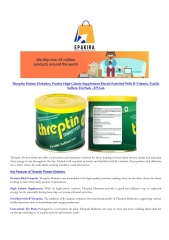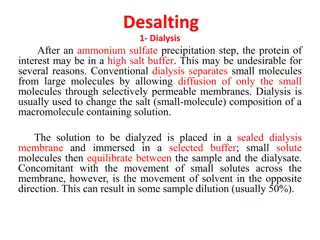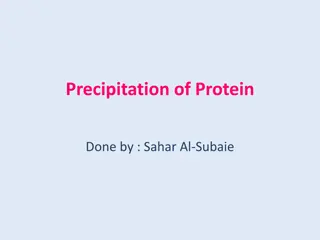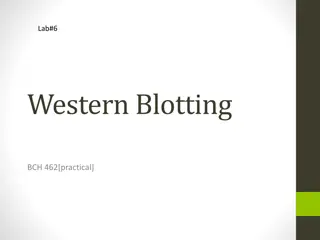
Protein Separation by SDS-PAGE and Electrophoresis Techniques
Learn about protein separation using SDS-PAGE and electrophoresis techniques. Explore the principles, factors affecting mobility, equipment required, buffer solutions, supporting media, and materials needed for SDS-PAGE. Gain insights into the importance of electrophoresis in biochemistry, molecular biology, and biotechnology.
Download Presentation

Please find below an Image/Link to download the presentation.
The content on the website is provided AS IS for your information and personal use only. It may not be sold, licensed, or shared on other websites without obtaining consent from the author. If you encounter any issues during the download, it is possible that the publisher has removed the file from their server.
You are allowed to download the files provided on this website for personal or commercial use, subject to the condition that they are used lawfully. All files are the property of their respective owners.
The content on the website is provided AS IS for your information and personal use only. It may not be sold, licensed, or shared on other websites without obtaining consent from the author.
E N D
Presentation Transcript
Protein separation by SDS PAGE Presented by Dr.K.ANBARASAN Assistant professor and Head Department of Botany Padmavani Arts and Science College for Women Salem - 636 011.
ELECTROPHORESIS Electrophoresis is a molecular technique widely used in field of biochemistry, molecular biology and biotechnology to separate the bio molecules based on the migration of charged molecules. The rate of migration depends on the strength of electric field, size and shape of the molecules.
When charged molecules are placed in an electric field they migrate towards either the positive (anode) or negative (cathode) pole according to their charge. Principle
Factors affected electrophoresis mobility Net charge of the molecule Size and shape Concentration of molecule in solution Electric strength
Electrophoresis unit Electrodes Buffer tanks or chambers Supporting medium Spacer & comb Transparent insulating glass plates DC power supply
Electrophoresis Media Buffer Supporting medium Buffer: Solution of week acids or salts Functions of buffer 1. carries the applied current 2. determine the electric charge on the solute 3. Maintains the pH Commonly used buffer Phosphate buffer Tris borate buffer Tris glycine buffer
Supporting medium Features of supporting media Chemical nature Availability Transparency Adsorptivity Sieving effect Preparation Porosity Electrical conductivity Commonly used supporting media Paper(Cellulose) _ Inert Easy High Low desirable Easy Controlled High Poor conductor of electricity e.g. What mann paper It used to separation of clinical medicine It used for separation of some iso- enzymes Agarose is purified form of agar, it is polysaccharide used for nucleic acid separation. It is inert and highly transparent and also used for protein and amino acid separation. Cellulose acetate Starch Agarose Polyacrylamide gel
SDS-PAGE (Sodium Dodecyl Sulfate Polyacrylamide gel Electrophoresis ) Materials needed: Vertical electrophoresis apparatus Power pack 30% Acrylamide mix (29% Acrylamide and 1% Bis-acrylamide) 1.5M Tris (pH 8.8) 1M Tris (pH6.8) 10% SDS 10%APS (Freshly prepared) TEMED(N,N,N ,N -Tetra methylene diamine) Tris-Glycine electrophoresis buffer Staining solution Distaining solution Distilled water
Role of Reagents Polyacrylamide, as medium for vertical gel electrophoresis it composed of a mixture of two chemicals: acrylamide and bis- acrylamide. Acrylamide forms long polymer chains. Bisacrylamide is cross linking agent and links long polymers of acrylamide. Both these components will form a cross linked network in the presence of APS called polymerization. APS (Ammonium Persulfate) is polymerizing agent which generate free radicals(charged oxygen) in the presence of TEMED (is a free radical stabilizer) Air inhibits polymerization as it scavenges free radicals Pore size is determined by % of acrylamide and the amount of cross linker.
SDS SDS is used in the gel mix. SDS is ve charged and binds to proteins, it denatures (unfolds) proteins and gives a net negative charge. Proteins will then migrate to the anode. Proteins all have same charge to mass ratio Can be separated based on size alone Biomolecules moved with a speed dependent on their charge, shape, and size and separation occures on the basis of molecular size.
Stacking gel This gel has a large pore size and a lower pH than the separating gel so the protein sample are easily pass through the gel. Separating gel or resolving gel As the proteins migrate through the resolving gel, the larger proteins will move more slowly and the proteins will be separated by size. Stacking gel (4%) Separating gel (12.5%) Acrylamide - bisacrylamid(30%) 0.5M Stacking buffer(pH 6.8) 10% SDS 850 l Acrylamide - bisacrylamid(30%) 1.5M Separating buffer(pH 8.8) 10% SDS 2.08 ml 625 l 1.25 ml 50 l 50 l 10% APS 50 l 10% APS 50 l TEMED 5 l TEMED 2 l Distilled water 3.45ml Distilled water 1.61 ml
Staining solution Coomassie brilliant blue (Dissolve 15mg coomassie brilliant blue in 0.2ml methanol and add 9.8ml of distilled water Destaining solution - I Methanol - 375ml Acetic acid - 35ml Distilled water - 215ml Destaining solution II Methanol - 250ml Acetic acid - 35ml Distilled water - 215ml
Procedure Assemble the glass plates Prepare acrylamide separating gels) Pour the separating gel into the glass plate and keep in room temperature Keep for polymerization about 30 40 minutes (After 30minute is complete polymerization) Pour the stacking gel solution directly on to the surface of the polymerized resolving gel Immediately insert a clean comb in to the gel solution solutions (Stacking and
While the stacking gel is polymerizing and prepare required volume of protein samples Heat the samples in boiling water both for 2min to denature the proteins. Keep them on ice to retain the denature state. Add electrophoresis buffer to the top and bottom buffer chambers of the electrophoresis apparatus. Remove the comb carefully, after the polymerization and load the sample along with marker proteins into the wells.
Attach the apparatus to power supply unit and apply electric power of 50 to 100V Run the gel until bromophenol blue dye reaches the bottom of resolving gel
Turn of power supply and remove the glass plate from the electrophoresis apparatus The gel was immersed at least 100ml of staining solution (Coomassie blue) and kept overnight at room temperature. The gel was then destained by soaking it in the destaining solution for every 2 hours, the destaining solution was changed and it was repeated to about 3 4 times After destaining; the gel was stored in 20% glycerol in a sealed plastic bag Visualize the bonds in an illuminator and take the photographs. The molecular weight of the bands seen on the gel was indicated by the position of the molecular weight marker protein.






















